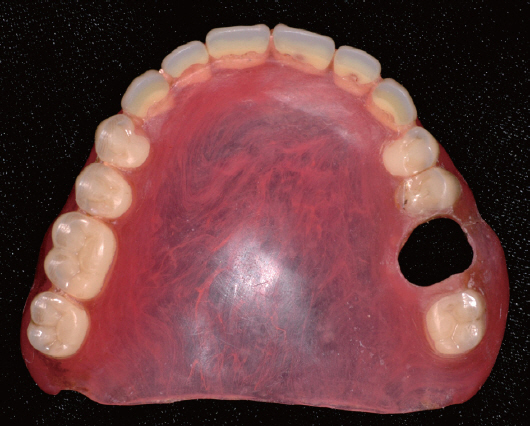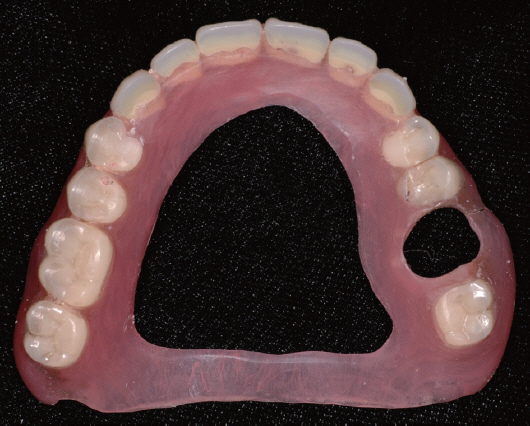J Dent Rehabil Appl Sci.
2017 Mar;33(1):19-24. 10.14368/jdras.2017.33.1.19.
Palate bone exposure from flexible denture: a case report
- Affiliations
-
- 1Department of Prosthodontics, School of Dentistry, Chosun University, Gwangju, Republic of Korea. lkj1998@chosun.ac.kr
- KMID: 2377055
- DOI: http://doi.org/10.14368/jdras.2017.33.1.19
Abstract
- Recently, flexible denture is widely used with some advantages such as esthetics, flexibility and biocompatibility. However, there is an opposite opinion about stability because of the movement of denture by the material's flexibility. As the denture moves to tissue surface during mastication, it irritates the supporting tissue. It can lead to trauma and rapid resorption of residual ridges if this irritation lasts for a long time. In this case, the patient has used flexible denture with insufficient stability, retention and support for several years and thus continuous irritation of the supporting tissue resulted in palate bone exposure. The patient discomfort and palate bone exposure underwent improvements by the new denture with stability and retention. A careful case selection for flexible denture, regular checkup and proper treatment are necessary to prevent the side effects.
Keyword
Figure
Reference
-
References
1. Weintraub JA, Burt BA. Oral health status in the United States: tooth loss and edentulism. J Dent Educ. 1985; 49:368–78. PMID: 3891805.2. Tomlin HR, Wilson HJ, Osborne J. The thickness and hardness of soft tissues. A preliminary clinical survey. Br Dent J. 1968; 124:223–6. PMID: 5237564.3. Cowan RD, Gilbert JA, Elledge DA, McGlynn FD. Patient use of removable partial dentures: two- and four-year telephone interviews. J Prosthet Dent. 1991; 65:668–70. DOI: 10.1016/0022-3913(91)90204-A.4. Budtz-Jørgensen E, Bochet G, Grundman M, Borgis S. Aesthetic considerations for the treatment of partially edentulous patients with removable dentures. Pract Periodontics Aesthet Dent. 2000; 12:76572.5. Singh JP, Dhiman RK, Bedi RP, Girish SH. Flexible denture base material: a viable alternative to conventional acrylic denture base material. Contemp Clin Dent. 2011; 2:313–7. DOI: 10.4103/0976-237X.91795. PMID: 22346159. PMCID: PMC3276859.6. Shamnur SN, Jagadeesh KN, Kalavathi SD, Kashinath KR. “Flexible dentures”- an alternate for rigid dentures? J Dent Sci Res. 2005; 1:74–9.7. Thakral GK, Aeran H, Yadav B, Thakral R. Flexible partial dentures - a hope for the challenged mouth. PJSR. 2012; 5:55–9.8. Atwood DA. Bone loss of edentulous alveolar ridges. J Periodontol. 1979; 50:11–21. DOI: 10.1902/jop.1979.50.4s.11. PMID: 287775.9. Atwood DA, Coy WA. Clinical, cephalometric, and densitometric study of reduction of residual ridges. J Prosthet Dent. 1971; 26:280–95. DOI: 10.1016/0022-3913(71)90070-9.10. Coelho CM, Sousa YT, Daré AM. Denture related oral mucosal lesions in a Brazilian school of dentistry. J Oral Rehabil. 2004; 31:135–9. DOI: 10.1111/j.1365-2842.2004.01115.x. PMID: 15009597.11. Sato T, Hara T, Mori S, Shirai H, Minagi S. Threshold for bone resorption induced by continuous and intermittent pressure in the rat hard palate. J Dent Res. 1998; 77:387–92. DOI: 10.1177/00220345980770020701. PMID: 9465171.12. Park CW, Hwang YP, Kay KS. Prosthetic restoration of partially edentulous patients using the Valplast flexible partial denture system. Oral Biol Res. 2006; 30:55–73.13. Glantz PO, Stafford GD. The effect of some components on the rigidity of mandibular bilateral free end saddle dentures. J Oral Rehabil. 1980; 7:423–33. DOI: 10.1111/j.1365-2842.1980.tb00461.x.14. Kitamura S, Suzuki Y. In vivo assessment of occlusal stress distribution in distal extension removable partial dentures: connecting rigidity and denturesupporting area affecting the stress distribution. Tsurumi Univ Dent J. 2006; 32:117–24.15. Igarashi Y, Kawata M, Asami M. The connecting rigidity between abutment teeth and retainers in RPDs. Part 1: the connecting rigidity in various clasp retainers. J Jpn Prosthodont Soc. 1990; 34:1162–9. DOI: 10.2186/jjps.34.1162.16. Igarashi Y, Kawata M, Shiba A. Restoration of the “supporting zone” of the mandible in partial dentate mouth (Part 5). Supporting ability of free-end saddle RPD’s. Showa Shigakkai Zasshi. 1987; 7:195206.17. Qudah S, Harrison A, Huggett R. Soft lining materials in prosthetic dentistry: a review. Int J Prosthodont. 1990; 3:477–83. PMID: 2088386.
- Full Text Links
- Actions
-
Cited
- CITED
-
- Close
- Share
- Similar articles
-
- Flexible IARPD considering the prevention of combination syndrome: a case report
- Removable Partial Denture in a Cleft Lip and Palate Patient: A Case Report
- Management of flabby ridges using liquid supported denture: a case report
- Prosthetic treatment for patient with congenital bilateral cleft lip and palate to close oro-nasal communication using maxillary double crown and clasp retained removable denture
- Comparative analysis of case series for the prosthetic rehabilitation of edentulous patients using suction denture





